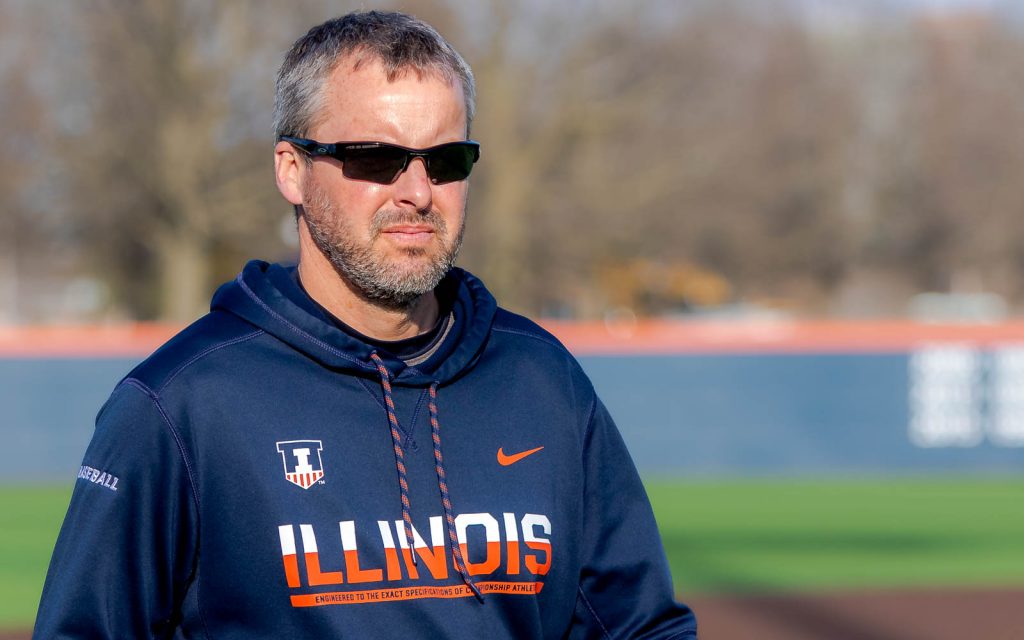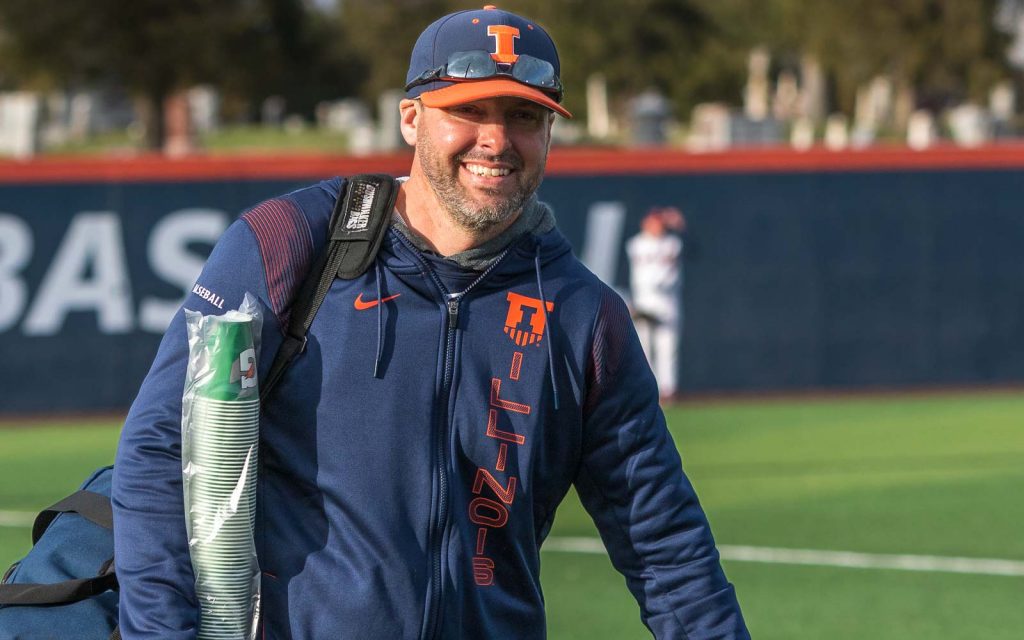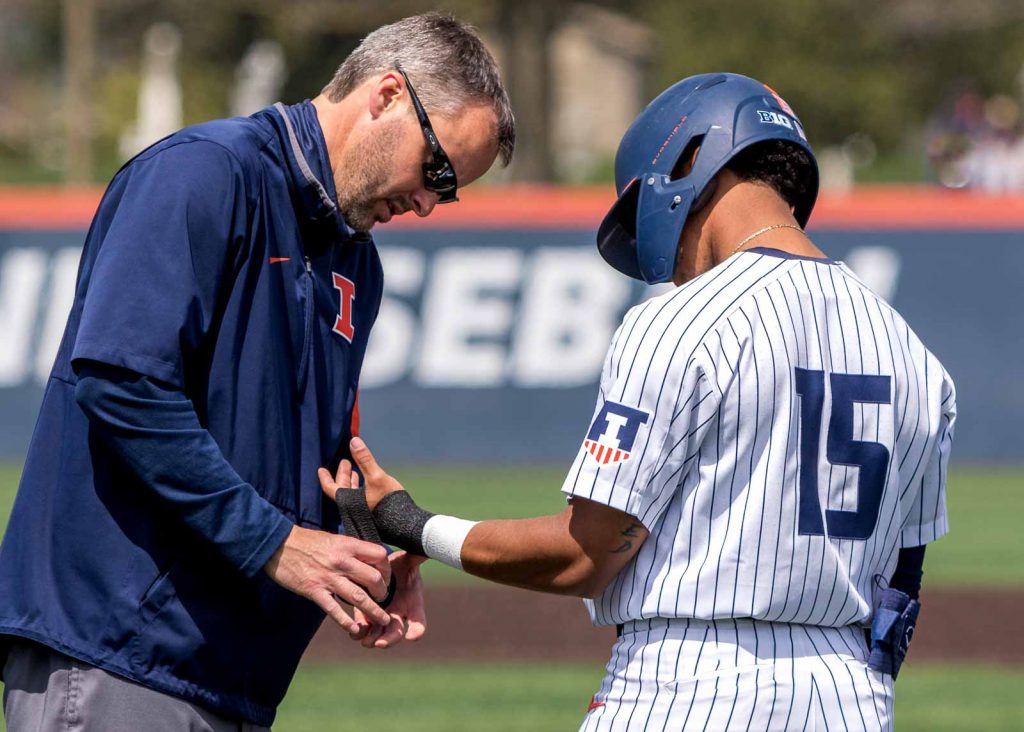
If you attend Illinois baseball games, you have most likely seen Jim Halpin along the sidelines or in the dugout. As head athletic trainer for the team, he is there at every game. Jim plays an important and even critical role in the development of the players.
I’ve been wanting to feature Jim on this site for a while. He graciously took some time from preparing for the season and answered some burning questions for the Illinois Baseball Report.
Give us some background on who Jim Halpin is and how he got to the University of Illinois.
“I grew up in Prophetstown, IL and attended high school there. I went to undergrad at Illinois State University and grad school at University of Iowa.
Prior coming to U of I, I was working with a clinic in Rockford, IL, covering a high school and working as the head athletic trainer for the Rockford RiverHawks who were in the Frontier League. Prior to that I was the head athletic trainer for the Rockford Lightning, who were part of the CBA (Continental Basketball Association), I worked with the Cincinnati Reds in Sarasota, FL, and completed an internship at Kennedy Space Center.”
Your official title at the Division of Intercollegiate Athletics is Associate Athletics Trainer. Can you expand on the scope of your position? What are you responsible for at the DIA?
The main focus of my position is as the head athletic trainer for the baseball program. Additionally, I’m responsible for managing our Gatorade budget for the DIA and coordinating all of our EMS coverage for home athletic events. Within the sports medicine department, I manage the FICE (Fighting Illini Center for Excellence) athletic training room.

Let’s say it is a game day for Illinois baseball. Describe what a typical day is like for you. Is there a typical day?
Each day is usually pretty unique, no 2 days are the same. But a fairly typical game day for a 6pm start would be:
Cover any morning workouts that we may have that day. Get to the field around 1pm to start setting up the dugouts and get things ready in the athletic training room. Players start to arrive and we do any pre batting practice treatments. Players go out to stretch at 3:30pm and take BP following that, so I am on the field making sure everything runs smoothly.
After BP, back in the clubhouse for any additional pregame treatments, while also making sure the visiting team doesn’t need anything during their BP time. Players get ready for the game and take In/out. I have time to make any more preparations, make sure EMS is on site, and no one needs anything else. Game starts at 6pm and I’m in the dugout for the entire game providing medical coverage, watching the weather, helping manage any other aspects of the game that the head coach needs assistance with.
Games usually take around 3 hours, so about 9pm we are back in the clubhouse. I provide any post game treatments needed for any injuries, clean up the dugouts and training room. Make any preparations I can for the next day and head home.
So if there is a typical game day, it is usually about 9-10 hours as long as we don’t have any issues.
Rapid Response questions with Jim Halpin
| Favorite sports team outside of Fighting Illini? | “Have to go with the Cardinals” |
| Most rewarding part of your job? | “Watching the guys succeed” |
| What’s the best advice you would pass on to someone interested in the athletic training field of work? | “Get as much experience as you can, ask questions, do internships, just try to be around it as much as you can and learn as much as you can. A lot of what I do I learned from other people in field” |
| Favorite memory of Illinois baseball?? | “I’ve been here for awhile so there are a lot, but of course that 2015 season is tough to beat” |
What type of training is required for someone in your position? How do you stay up to date on the latest training techniques and technologies?
When I went through school, you could get an undergrad degree in Athletic Training, which I did at Illinois State University, and be eligible to sit for the national exam. That has since changed and you must get a masters degree to sit for the national exam. Once you pass the national exam and become licensed in whatever state you are in, you can begin working as an athletic trainer.
To stay up to date, we must complete 50 continuing education units every 2 years to maintain our certification. This can be anything from learning new skills, attending seminars, online courses, etc.
“Having a good relationship with the players is crucial”

Can you give us some insight into the diagnostic process of a potential injury or soreness? What happens when further medical attention for a player is needed?
When a player is injured, I will do the initial evaluation. If it is a more serious injury that I think needs further attention, I will refer him to our team physicians who will evaluate him and decide if any imaging or further evaluation is necessary.
At that point we come up with a plan of care, including treatments, rehabs, and progression back to full participation. Once we reach certain marks, the team physician will follow up and give final clearance for the athlete to return to participation.
I must think you have established a bond with the players on the Illinois baseball team. Does that relationship help when treating them or providing advice? Are players pretty good about listening to your advice or following your plan of action?
Having a good relationship with the players is crucial. I’m lucky, we have a good group of guys that want to work hard and play every day. When it comes to injuries, it can be tough to get through, so the trust that they have in me really helps to get them back on the field.
I want to thank Jim for his time and effort for his thoughtful answers, even if he is a Cardinals fan.
Seriously, I have interacted with Jim plenty of times at Illinois Field and he is top-notch and a credit to the program.
Thanks, Jim for keeping our student-athletes healthy!



